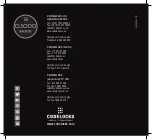
6
7
CL5010 INSTALLATION
INSTALLATION OF LOCKS
CL5010 Installation..................Pg. 6-8
CL5010BB Installation.............Pg. 8-9
CL5010PK Installation.................Pg. 9
CL5020 Installation..............Pg. 10-11
Take time to be precise and
finish the job quicker.
Installation holes must be drilled
in exactly the correct positions and
precisely at right angles to the door
surface. Lock components must be
vertically and horizontally accurate in
relation to each other and to the door.
WEDGE THE DOOR FIRMLY TO
PREVENT MOVEMENT WHILST
DRILLING AND CHISELING.
Lightly mark a height line on the edge and both faces of the door and on the door
jamb, to indicate the top of the lock when fitted. Crease the template along one of the
dotted lines (60mm (2
3
/
8
") or 70mm (2
3
/
4
") latch) and tape it to the door with the top
in line with the height line. Mark the holes to be drilled. Mark the centre line of latch
on to the door edge.
Apply the template to the other side of the door precisely against the height line and
the centre line of latch mark. Mark the holes to be drilled again. (See diagram A).
Keeping the drill level and straight, drill a 25mm (1") hole in the centre of the door
edge to accept the latch.
Keeping the drill level and straight, drill the holes in the door face. Drill from both
sides of the door to increase accuracy and to avoid damage to the other side when a
drill goes right through.
Put the latch into the hole and, holding it square to the door edge, draw around the
faceplate. Starting with the top and bottom cuts, chisel a rebate to allow the latch face
to flush with the door edge. (See diagram B).
Fix the latch with the wood screws, with the bevel towards the door frame.
Fit the latch support post on the inside of the front plate, in hole A for a right hand
hung door and hole B for a left hand hung door. (See diagram C).
1
2
3
4
5
6
CL5010
Template
CL5010
Inside
Front
Plate
Screw the cable tube into the front plate, passing the cable
through the tube. For doors less than 45mm (1
3
/
4
") thick, screw
the tube all the way to the end of the thread. For doors more than
45mm (1
3
/
4
") leave an appropriate amount of thread showing to
accommodate ring nut. Example: For a 60mm (2
3
/
8
") thick door,
leave 15mm (
3
/
5
") of thread showing.
Fit the self-adhesive gaskets to the front and back plates.
The gaskets provide friction against the door so that it is not
necessary to over-tighten the fixing bolts to provide stability.
Remove the 4 socket head bolts from the back plate (2 are found
under the battery cover). This will release the inside fixing plate.
Cut the fixing bolts to correct length. Measured from beneath
the bolt head, the length should be the door thickness, plus
approximately 15mm (
3
/
5
") to the nearest cutting point of the bolt.
N.B.
Always cut the bolts at one of the cutting points so as not
to damage a thread. Use the cutting edges of pliers to crimp
strongly several times around the selected cutting point. The
surplus end should break off quite easily.
Put the spindle into the latch with the spring on the front plate
side of the door.
Apply the front plate over the spindle, passing the cable tube
through the door and the latch support post through the latch.
Place the fixing plate over the cable tube and spindle. Screw the
ring nut onto the cable tube until finger tight. Fit the alignment
insert over the spindle. Screw the fixing bolts through to the front
plate. (See diagram D).
7
8
9
10
11
12
Check that the spindle turns freely, and the latch retracts and
projects smoothly, with the alignment insert in place. If it is tight,
loosen the fixing bolts slightly and adjust the position of the
fixing plate until the spindle will turn freely. Tighten the fixing
bolts. Test the spindle again. Do not over-tighten the bolts as this
may cause the door to distort and affect the lock function.
REMOVE THE ALIGNMENT INSERT.
13
Continued overleaf
Alignment insert
MUST be removed
before completing
installation.
6







